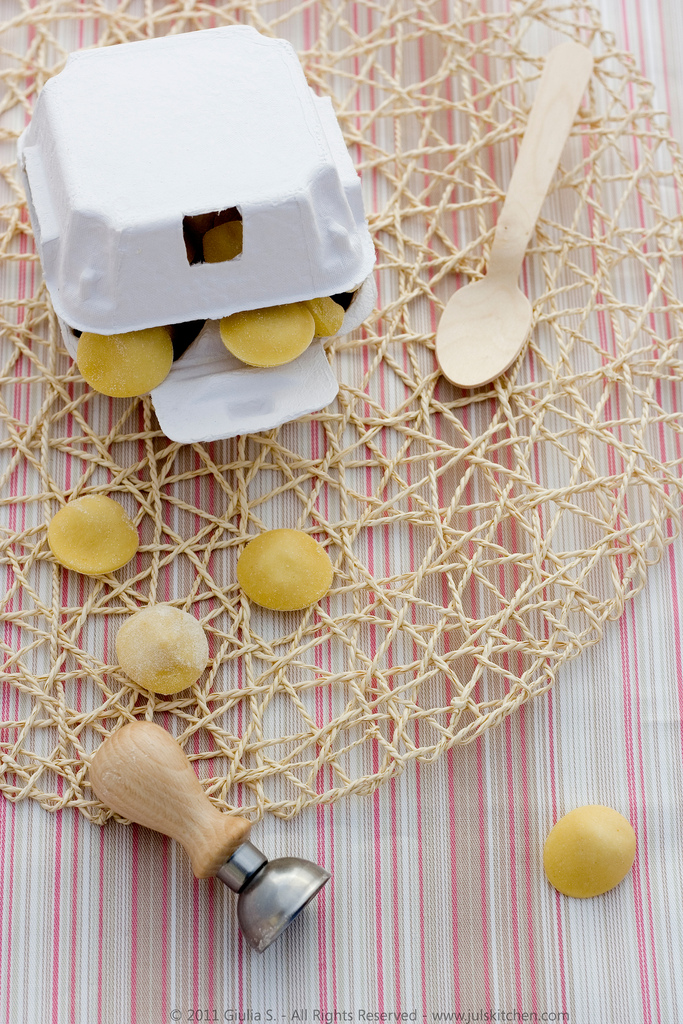Chestnuts in Tuscany and a chestnut flour fresh pasta with walnut sauce
My grandmother has a sweet tooth, she has always room for dessert. When she was a child, before going to school, she would stop at a local mill, owned by the family of one of her friend, and they would pick a handful of dried chestnuts from the big sacks that would soon be turned into flour. They would stash the dried chestnuts in their pockets and go to school. That was their morning snack, simple, sweet and nutritious.
So even here, in the hills in between Florence and Siena, chestnuts and chestnut flour were important ingredients in the economy of a household.
Today, buying good quality chestnut flour can be difficult, and it is certainly more expensive than it used to be. A good local organic stone ground wheat flour costs about 2€ a kilo. If you want to buy an organic, stone ground chestnut flour made with local chestnuts, that flour can cost from 10€ up to 15€ a kilo. It used to be the flour of poor people, of those who could not afford, or get hold of, wheat flour, and now it is considered a delicacy, as it is a gluten free flour, very nutritious, rich in fibres, minerals and vitamins.
Yet, chestnut flour is one of the most fundamental ingredients of the cucina povera, the peasant cooking, of the Tuscan mountains, from Garfagnana and Lunigiana, through the Appennino Pitoiese, down to Mugello and Mount Amiata, basically the whole mountain right side of Tuscany, from North to South. In the years of famine and poverty, chestnuts have supported the local population with their high calorie content and versatility. When the chestnuts become flour, they can be turned into polenta, porridge, bread, cakes, biscuits, fresh pasta and necci, which are a type of Tuscan crepes.

From chestnuts to flour
Traditional, in autumn, around October, chestnuts are collected and dried for about forty days in a little hut in the woods, where the fire is fed with chestnut wood. Once dried, they are gradually ground into flour by millstones. The best time to buy chestnut flour is therefore after the second half of November, when the new flour is finally available at market.
Chestnut flour has been known for centuries as farina dolce, sweet flour. Why? Put a pinch of chestnut flour on your tongue and let it melt. It is exactly like chewing into a sweet and dry chestnut. This opens up endless possibilities, as you can drastically reduce the amount of sugar you use in sweet recipes if you use chestnut flour, or even skip it all together, as in the castagnaccio.

Let’s start our chestnut tour of Tuscany with Lunigiana.
Lunigiana is a slice of Tuscany wedged between Liguria and the sea, the Apuane Alps and Emilia Romagna. It is very different from the typical idea of Tuscany, with vineyard and olive groves. Its cuisine is strongly linked to the forest. Chestnuts and mushrooms, for instance, have fed the Lunigiana peasants for generations. Chestnut trees were present in Lunigiana from the I century A.D, but it was during the V and VI centuries that this cultivation increased to a great extent.
Chestnut flour is the key ingredient of traditional recipes, including Tuscan chestnut gnocchi boiled in milk, castagnaccio and marocca, a dark bread made with chestnut flour. Today Marocca di Casola is made with soft wheat flour, chestnut flour and mashed boiled potato. This makes a dense, spongy bread that teams up perfectly with ricotta, honey, anchovies, lardo di Colonnata or local pancetta. Marocca di Casola is also listed as a Slow Food product.
In Lunigiana there’s also a kind of fresh pasta known as bastarda, illegitimate, as the wheat flour is cut with a percentage of chestnut flour. I’m sharing the recipe at the end of this post.

Garfagnana, a neighbouring area, is constantly competing with Lunigiana for who makes the best chestnut flour.
Both flours are a DOP, so a product certified in its quality and in its productive process by the European Union.
Garfagnana was for a long time a poor and isolated area, contended for by the nobles of Ferrara, Lucca and Florence. Today it is a favourite among tourists, offering an atypical experience of Tuscany, with its oak and pine woods, chestnut groves, castles and fortress towns, watchtowers and crumbling churches. In addition to its lovely landscapes, Garfagnana is also esteemed for its authentic food and wine traditions, rich with local products that tell of a past marked by deprivation and inventiveness. Garfagnana has strong ties with spelt, its most characteristic product. Along with spelt, chestnuts, a local corn known as formenton otto file and other forest products like mushrooms and game have sustained this population for centuries.
The local chestnut flour is used to make manafregoli, a soft chestnut polenta served with cold milk or cream, or a very nutritious polenta, traditionally served with ricotta, sautéed mushrooms and charcuterie. Chestnut flour is also the key ingredient to make castagnaccio.

Castagnaccio is probably the most representative recipe that is made with chestnut flour in Tuscany.
It is a thin chestnut cake, an old sweet treat that tells of a time when poverty and hardship were resolved by housewives’ ingenuity. In its simplest version, it is enough to stir a handful of chestnut flour with water, olive oil and rosemary and bake it into a cake with a sharp, almost smoky flavour, with a thick texture similar to a bread pudding.
Talking about castagnaccio in Tuscany, however, might be a thorny issue, because each area uses different dried fruit or focuses on different nuances of flavours. Until recently, I always thought a combination of raisins and pine nuts was best, but now I prefer the castagnaccio of Garfagnana, where you can also find walnuts and the kick of orange zest, which adds a citrus note and turns the castagnaccio into a sweet treat with a typical Christmas flavour. You can find my basic recipe for castagnaccio here on the blog.

Moving towards the Appennino Tosco-Emiliano or Pistoiese, we find another poor area whose sustenance has long relied on chestnuts and polenta.
This is where you can find necci. Nothing could seem simpler than castagnaccio, right? That is, until you try necci for the first time. I myself did not know what they were until a few years ago, since typical snacks for me had always been grilled bread topped with olive oil in winter, bread with tomato in summer and, often enough, tea with cookies.
These thin crêpes originate in the Garfagnana area, the Pistoia Mountains and Tosco-Emiliano Apennine mountains. They are served either immediately on their own, or filled with sausage, pancetta or sheep milk ricotta.
You can read more about necci here, there is also a video where you can see how easy and straightforward the procedure is.

If you are in Florence, you can have the chance to try the delicious necci made by Signora Lucia of the farm L’Alberaccio, for 30 years a regular fixture at the Fierucola market in Piazza Santissima Annunziata. Today she sells her necci in Santo Spirito as well. Lucia farms her own estate of about 10 hectares, including a wooded area. A small part of her enterprise is growing garden vegetables, apples and pears. But chestnuts make up most of her production.
The chestnuts are dried in the traditional way, then ground at a certified stone mill. With the resulting flour, Lucia makes her necci with ricotta. Stop by to chat with her and her grandson, and observe what attention her husband Giorgio pays to preparing their snack.
And now, since we’re in Florence, let’s move towards Mugello.
Until a few years ago, I thought of the Mugello region as simply the place that produced the good milk I was raised on. Then I met Tommaso. His family is from Mugello, and he grew up there until the age of 12 when the family moved to Florence.
Mugello has practically a cult of chestnuts: in the past, they were necessary to stave off starvation but there is a generally profound respect for chestnut trees here, the tree of bread.
Don’t call them simply chestnuts, though: in Marradi, a town of Mugello, there is a typical product called the marron buono IGP, larger than a regular chestnut and ideal for high quality marron glacé.
If in Lunigiana and Garfagnana what is protected by the European Union is the flour, here, and in the Amiata Mountain, the chestnuts, or better, the marroni are an IGP product, a protected geographical indication.
We have seen that chestnut production in Tuscany boasts a tradition that goes back centuries. The first historical accounts of the presence and cultivation of chestnut trees date back to the Middle Ages, although it was already present in the Mugello area in Roman times. For centuries, the chestnut woods have represented the main source of income for the area.
Here, chestnuts are eaten in their purest forms: boiled in water, salt and fennel seeds, and known as ballotte, or served as caldarroste, roasted in a pan over an open fire, and known also as bruciate, or even ubriache, that is drunk, by being tossed into a glass of red wine.
The local marrone is also used to give flavour and body to roast or stewed meat, or as a base ingredient for chestnut cakes and desserts, as well as for producing flour and a jam. Chestnuts were also the filling of the local tortelli before the potatoes were introduced in the local economy.
Chestnut flour is also used as a substitute for wheat flour to make gnocchi, seasoned with brown butter and sage to enhance the woody, autumnal taste. A tablespoon of chestnut flour can even be stirred into a risotto to add a smoky flavour and an incredible creaminess, especially with a porcini risotto.
And now, let’s move to Mount Amiata, home to many chestnut trees and producers.
Here chestnuts were considered the bread of the poor, and until the first half of the XX century chestnuts constituted the only means of survival for a major part of the population. They make a rich chestnut polenta served with ammazzafegato, liver-killer, a local sausage that is far from light.
Chestnuts can be boiled or roasted. They also make a filling winter soup with potatoes, mushrooms and chestnuts, that I love, and that you can find here on the blog. Chestnut flour can also be used to make fresh pasta, fritters, polenta or castagnaccio. Here chestnuts are even used in the production of a local artisanal beer.

Lasagne bastarde di castagne con sugo di noci – Chestnut Flour fresh pasta with walnut sauce
And now to the recipe, as promised. This is an extract from our book From the markets of Tuscany: a cookbook.
Fresh pasta is like a touchstone. It centers you in a precise moment, place, and tradition, at a table of guests speaking a specific dialect or accent. In the Mugello region, a border land characterized by scarcity, the simplest pasta filling calls for boiled potato and garlic. In the Maremma, the local version of ravioli are not made with spinach but borage rather, evidence of a sustenance economy that relies on foraging.
Here in the Lunigiana, pasta is sometimes known as bastarda, meaning “illegitimate”, as the wheat flour is cut with some chestnut flour. The lasagna made in this area is comprised of irregularly shaped pieces of eggless pasta, with only a small amount of water and lots of elbow grease. Usually the percentage is 3 parts to 1, where chestnut flour is used in a smaller amount as it is a gluten free flour, so it is almost impossible to make fresh pasta just with chestnut flour.
Knead the dough by hand until it is smooth and silky. This fresh pasta can be cooked as soon as it’s rolled out, or left to dry near a stove or other source of heat. When completely dried, the pasta can be stored in paper sacks for months, ready to be cooked and seasoned. The following fresh pasta and sauce recipes come courtesy of Mariangela of the Antico Molino Rossi mill, who described the method and ingredients for me while we maneuvered between the stone mill and sacks of chestnut flour.
Chestnut Flour Fresh Pasta with Walnut Sauce
Print Recipe Pin Recipe Share by EmailIngredients
For the pasta
- 375 g all purpose flour
- 125 g chestnut flour
- 1 tablespoon extra virgin olive oil
- 1 pinch salt
- 250 ml water
For the sauce
- 100 g shelled walnuts, plus more, crushed, for garnishing
- 1 clove garlic
- 100 g cooking cream
- salt
- grated Parmigiano Reggiano
Instructions
- Mix the flours together on a wooden pastry board. Add the oil and salt. Pour the water in a little at a time, working the flour with your fingertips. When the texture becomes crumbly, begin to knead with your hands. The more you knead, the more glutens will form, which will strengthen the pasta sheets. The movement is all in the wrist: roll the pasta outwards in front of you, then fold it over onto itself and repeat the rolling movement. When the ball of dough is smooth, silky and no longer sticky, wrap it in plastic wrap and let rest for 30 minutes at room temperature.
- Roll the dough out to a very thin, wide, uniform sheet of pastry. Dust with semolina and let dry on the board for about 20 minutes, until the dough is no longer sticky. Cut into rough squares and diamond shapes with a pizza cutter or sharp knife. The pasta can be used immediately or dried thoroughly and stored in a paper sack for months.
- Cook the pasta in boiling salted water until al dente. Drain the pasta, reserving some of the water. Prepare the sauce.
- Process the walnuts with a clove of garlic, the cream, a pinch of salt and a ladle of the pasta cooking water. Dress the pasta with the sauce and add a generous dusting of grated Parmesan and a few broken pieces of walnut.

Episode 32 – Chestnuts and chestnut flour in Tuscan cuisine
Listen to “EP. 32 – Chestnuts and chestnut flour in Tuscan cuisine” on Spreaker.
 Ciao! Questo contenuto è disponibile anche in Italiano.
Ciao! Questo contenuto è disponibile anche in Italiano. 





Hi Giulia!
Should i cook the sauce inany way? Or should i just mix the dressing with the hot pasta in a saucepan?
Kind regards,
Pierre
Hello Pierre! you do not need to cook the sauce, just mix it with the hot pasta in a saucepan!
Thanks for this – super interesting and I am looking forward to making the chestnut flour pasta and the necci
Thank you Jacqueline! so happy you’ll be trying the chestnut flour pasta and the necci! Chestnut flour is such a fascinating ingredient!